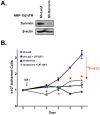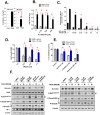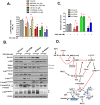Critical role of a survivin/TGF-β/mTORC1 axis in IGF-I-mediated growth of prostate epithelial cells
- PMID: 23658701
- PMCID: PMC3641055
- DOI: 10.1371/journal.pone.0061896
Critical role of a survivin/TGF-β/mTORC1 axis in IGF-I-mediated growth of prostate epithelial cells
Abstract
Survivin is a unique member of the inhibitor of apoptosis (IAP) proteins that is overexpressed in numerous cancers through poorly defined mechanisms. One such mechanism may be through constitutive activation of the insulin-like growth factor-I (IGF-I) signaling pathway, implicated in the development and progression of prostate cancer. Using the pre-neoplastic NRP-152 rat prostate cell line as a model, we showed that IGF-I induces Survivin expression, and that silencing Survivin by lentiviral-mediated small hairpin RNA (shRNA) represses IGF-I-stimulated cell growth, implicating Survivin as a mediator of this growth response. Moreover, our data support that the induction of Survivin by IGF-I occurs through a transcriptional mechanism that is mediated in part by the PI3K/Akt/mTORC1 pathway. Use of various Survivin promoter-luciferase constructs revealed that the CDE and CHR response elements in the proximal region of the Survivin promoter are involved in this IGF-I response. Transforming growth factor (TGF-β) signaling antagonists similarly activated the Surivin promoter and rendered cells refractory to further promoter activation by IGF-I. IGF-I suppressed levels of phospho-Smads 2 and 3 with kinetics similar to that of Survivin induction. Suppression of TGF-β signaling, either by TGF-β receptor kinase inhibitors or by silencing Smads 2 and 3, induced Survivin expression and promoted cell growth similar to that induced by IGF-I. TGF-β receptor antagonists also rescued cells from down-regulation of Survivin expression and growth suppression by pharmacological inhibitors of PI3K, Akt, MEK and mTOR. Sh-RNA gene silencing studies suggest that mTORC1 induces while mTORC2 represses the expression of Survivin by IGF-I. Taken together, these results suggest that IGF-I signaling through a PI3K/Akt/mTORC1 mechanism elevates expression of Survivin and promotes growth of prostate epithelial cells by suppressing Smad-dependent autocrine TGF-β signaling.
Conflict of interest statement
Figures








Similar articles
-
Insulin-like growth factor-I inhibits transcriptional responses of transforming growth factor-beta by phosphatidylinositol 3-kinase/Akt-dependent suppression of the activation of Smad3 but not Smad2.J Biol Chem. 2003 Oct 3;278(40):38342-51. doi: 10.1074/jbc.M304583200. Epub 2003 Jul 21. J Biol Chem. 2003. PMID: 12876289
-
Insulin-like growth factor I suppresses bone morphogenetic protein signaling in prostate cancer cells by activating mTOR signaling.Cancer Res. 2010 Nov 15;70(22):9106-17. doi: 10.1158/0008-5472.CAN-10-1119. Epub 2010 Nov 9. Cancer Res. 2010. Retraction in: Cancer Res. 2020 May 1;80(9):1902. doi: 10.1158/0008-5472.CAN-20-0679. PMID: 21062988 Free PMC article. Retracted.
-
Rb/E2F4 and Smad2/3 link survivin to TGF-beta-induced apoptosis and tumor progression.Oncogene. 2008 Sep 11;27(40):5326-38. doi: 10.1038/onc.2008.165. Epub 2008 May 26. Oncogene. 2008. PMID: 18504435 Free PMC article.
-
The anticancer effects of curcumin via targeting the mammalian target of rapamycin complex 1 (mTORC1) signaling pathway.Pharmacol Res. 2020 Jun;156:104798. doi: 10.1016/j.phrs.2020.104798. Epub 2020 Apr 8. Pharmacol Res. 2020. PMID: 32278045 Review.
-
Growing knowledge of the mTOR signaling network.Semin Cell Dev Biol. 2014 Dec;36:79-90. doi: 10.1016/j.semcdb.2014.09.011. Epub 2014 Sep 19. Semin Cell Dev Biol. 2014. PMID: 25242279 Free PMC article. Review.
Cited by
-
TGF-β1 signaling pathway serves a role in HepG2 cell regulation by affecting the protein expression of PCNA, gankyrin, p115, XIAP and survivin.Oncol Lett. 2017 May;13(5):3239-3246. doi: 10.3892/ol.2017.5814. Epub 2017 Mar 6. Oncol Lett. 2017. PMID: 28529566 Free PMC article.
-
Immunohistochemical expression of insulin-like growth factor-1Ec in primary endometrial carcinoma: Association with PTEN, p53 and survivin expression.Oncol Lett. 2020 Dec;20(6):395. doi: 10.3892/ol.2020.12258. Epub 2020 Oct 29. Oncol Lett. 2020. PMID: 33193855 Free PMC article.
-
Prostate Cancer Patients With Unmanaged Diabetes or Receiving Insulin Experience Inferior Outcomes and Toxicities After Treatment With Radiation Therapy.Clin Genitourin Cancer. 2017 Apr;15(2):326-335.e3. doi: 10.1016/j.clgc.2016.08.020. Epub 2016 Sep 8. Clin Genitourin Cancer. 2017. PMID: 27789181 Free PMC article.
-
Insulin Protects Cardiac Myocytes from Doxorubicin Toxicity by Sp1-Mediated Transactivation of Survivin.PLoS One. 2015 Aug 13;10(8):e0135438. doi: 10.1371/journal.pone.0135438. eCollection 2015. PLoS One. 2015. PMID: 26271039 Free PMC article.
-
Survivin as a Novel Biomarker in the Pathogenesis of Acne Vulgaris and Its Correlation to Insulin-Like Growth Factor-I.Dis Markers. 2016;2016:7040312. doi: 10.1155/2016/7040312. Epub 2016 Oct 10. Dis Markers. 2016. PMID: 27803511 Free PMC article. Clinical Trial.
References
-
- Liston P, Fong WG, Korneluk RG (2003) The inhibitors of apoptosis: there is more to life than Bcl2. Oncogene 22: 8568–8580. - PubMed
-
- Salvesen GS, Duckett CS (2002) IAP proteins: blocking the road to death's door. Nat Rev Mol Cell Biol 3: 401–410. - PubMed
-
- Dohi T, Okada K, Xia F, Wilford CE, Samuel T, et al. (2004) An IAP-IAP complex inhibits apoptosis. J Biol Chem 279: 34087–34090. - PubMed
-
- Song Z, Yao X, Wu M (2003) Direct interaction between survivin and Smac/DIABLO is essential for the anti-apoptotic activity of survivin during taxol-induced apoptosis. J Biol Chem 278: 23130–23140. - PubMed
Publication types
MeSH terms
Substances
Grants and funding
LinkOut - more resources
Full Text Sources
Other Literature Sources
Molecular Biology Databases
Research Materials
Miscellaneous

